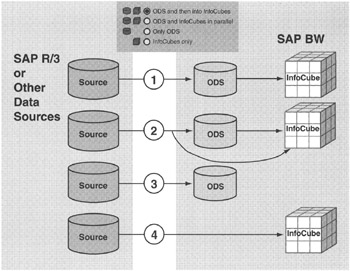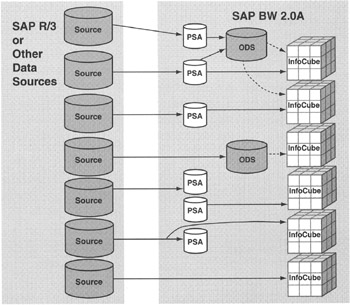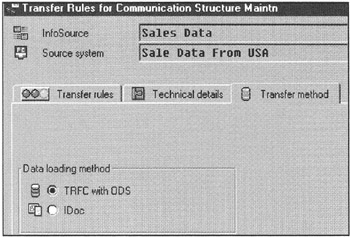Data Loading Strategies in SAP BW InfoCubes
By now, you are quite familiar with SAP BW architecture and different ways to load data in SAP, such as SAP R/3, SAP R/2, flat files, and staging BAPIs. This chapter discussed data loading techniques from SAP R/3 as the data source. Chapter 10, "Loading Data via Flat Files," describes how to load data from flat files, and Chapter 14, "Integrating Third-Party Products with SAP BW," describes methods to load data using staging BAPIs as well as third-party products.
Four classes of data objects exist in SAP BW. They store data for InfoCubes, ODS, Reference, and Warehouse operations. InfoCubes and ODS are primary objects to store transaction data. Note that you cannot store master data in the ODS. The question is why and when one needs to store data in ODS.
The original intent behind ODS implementation was to store raw data from its data sources, and then be able to manipulate data in ODS tables. However, in SAP BW 1.2B, once data was stored in the ODS, SAP did not provide any facility to manipulate data in the ODS; the only option was for someone to write ABAP code to clean or qualify data. By manipulating original data, you lose the originality of the data received, and the ability to trace it back to its origin in SAP R/3 is lost. SAP has virtually redesigned the ODS in SAP BW 2.0 to support the data warehouse industry's acceptable ODS model. Chapter 17, "The Operational Data Store in SAP BW 2.0," describes SAP BW 2.0A ODS architecture and possible implementation models in detail.
Though the scope of ODS in SAP BW 1.2B is limited, there are some scenarios in which you should consider storing transaction data in ODS:
-
Limited access to SAP R/3. Here you load small data sets in ODS frequently and run InfoCube loads based on data in ODS at a different time. For example, you want to load transaction data from SAP R/3 in ODS on an hourly basis but update the InfoCubes once a day or weekly from data in ODS.
-
One InfoSource to populate multiple InfoCubes. SAP BW does not support the broadcast model, meaning that the same data sets are sent to multiple SAP BW instances or multi InfoSources. In SAP BW 2.0, this logic may change, but such functionality still needs to be verified.
-
Resolve data quality problems. During loading data in an InfoCube, if a few records had invalid data or invalid master data references, you can edit such records in ODS and re-load selected records in the InfoCube.
-
Keep detailed data in ODS and summarized information in the InfoCube.
Figure 9-3 simply indicates that populated LIS structures are sent to SAP BW. But how and which method is used to send data to SAP BW is not known. The actual transfer method for such data objects is defined in SAP BW and not in the data sources, in this case SAP R/3 OLTP. The next section describes SAP BW data transfer options.
Data Transfer Methods
Figures 9-6 and 9-7 show transaction data paths in SAP BW. The data objects loading scheme is defined at InfoPackage schedule time. However, before you store data in ODS, you must define the data transfer mode to be tRFC with ODS as shown in Figure 9-8.

Figure 9-6: Data Load Paths in SAP BW 1.2B.

Figure 9-7: Data Load Paths in SAP BW 2.0A. The Early Customer Release is SAP BW2.0B, But it May Change.

Figure 9-8: Editing Transfer Rules for an InfoSource to Define InfoSource Data Transfer Method.
The transfer method needs to be set because SAP BW generates ABAP code in the background that defines how incoming data is to be dispersed and stored. If the tRFC with ODS option is not selected, the generated ABAP transfer program will not contain code that lets you save data in ODS. Moreover, by selecting this option, SAP BW will create an ODS physical database table. The ODS tables in BW 1.2B (PSA in BW 2.0) are named /BIC/B000000123. The ODS table is a transparent table and is defined the same as the transfer structure of associated InfoSources. All ODS tables in BW 1.2B (PSA in BW 2.0) are /BIC/B prefixed followed by a number sequence.
| Note | Remember the SAP BW 1.2B ODS objects are called PSA objects. The PSA object names are system-generated, such as /BIC/B00000123. However, the ODS objects in BW 2.0 are not system generated. They are user defined, such as /BIC/ORDDETAILS. |
What are the consequences of storing data in ODS? The biggest concern is disk space and extra data management. The data will grow faster than you anticipated. Moreover, saving data in ODS takes additional system resources. If you have low data volumes, InfoCubes have all the detailed information that is needed for your business and can be updated with new data in an acceptable timeframe; you can skip ODS completely.
When the transfer method is set for TRFC with ODS option and transfer rules are activated, you need to activate corresponding update rules for an InfoCube. Then you are ready to load data from SAP BW data sources.
| Note | You can load transaction data in ODS from any data source that SAP BW supports, such as SAP R/3, flat files, SAP R/2, or third-party data loading tools using staging BAPIs. You are not limited to storing transaction data in ODS when the data source is SAP R/3 OLTP. |
| Team-Fly |
EAN: 2147483647
Pages: 174